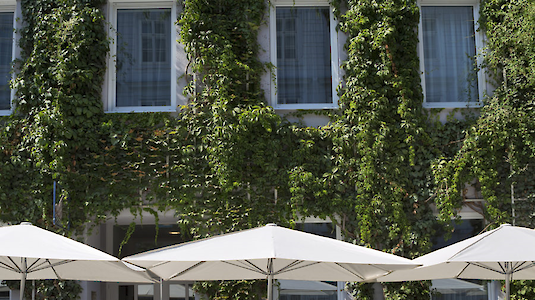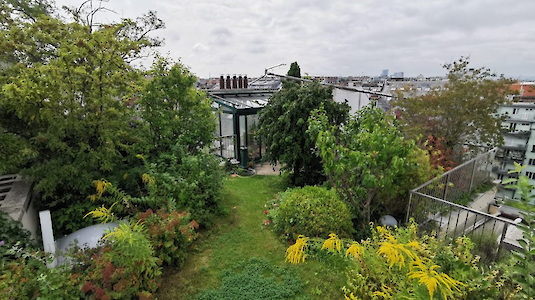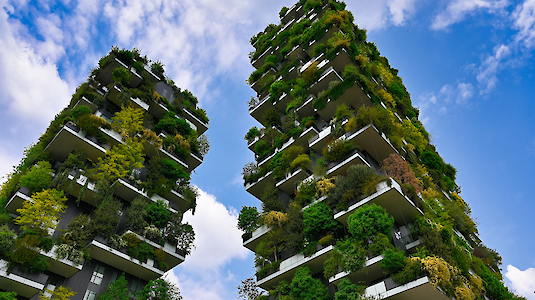Climate adaptation - green buildings and biodiversity
New construction - renovation - climate protection - biodiversity at the building? These are not contradictions, but potential synergies!
If biodiversity and building come together, then green roofs and facades must be mentioned! In the same breath, climate protection, or rather climate change adaptation, comes into play.
Green impacts
The greening of roofs and facades has a variety of effects on us humans and our environment. The following services provide an overview and do not claim to be complete.
- CO2 savings - through insulation against heat and cold. The planting of facades and roofs has an insulating effect in summer and by about two degrees in winter.
- Reduction of noise and pollution. In addition to positive effects on temperature and humidity, plants also have the ability to bind carbon dioxide and fine dust or smog. This supports CO2 reduction and O2 production.
- Increasing the life of the facade. A carefully planned plant cover serves as a natural protective shield against driving rain and UV radiation.
- Green environments increase productivity, concentration and human well-being. A natural environment helps us to regenerate more quickly and become ill less frequently (keyword: biophilia & phytophilia).
- Aesthetic added value. Facade greening as a design and aesthetic enhancement of the building stock, increases the attractiveness of buildings.
- Intensive green roofs can be used as valuable recreational spaces, full-fledged gardens or as a park. [1] [2]
Green facades
For ground-based greening of house walls, self-climbers (ivy, creeper), climbers (clematis, vine or wild rose) or bindweed (common hop, woodbines) can be placed. Walls wrapped in greenery in this way have much lower temperature fluctuations and create a more uniform climate inside the building.
Drought-tolerant succulents, grasses and wild perennials are suitable for facade-bound greenery. Private houses can use espaliered fruit as greenery.

A green wall: The Harmonie Vienna - An eco-labelled hotel in Vienna.
Green roof
A green roof also has a positive effect on the indoor climate of the rooms below. Especially in single-family houses or houses with low building heights, the effect is significant. In summer, the green roof provides cooling, while in winter it serves as thermal insulation.
Another advantage of green roofs is that the plants positioned there absorb rainwater. And through their transpiration, they release some of it back into the atmosphere. This creates evaporative cooling.
Extensive greening of roofs is implemented with different greening mixtures of mosses, sedums, herbs and wild grasses.
Greening on intensive roofs, on the other hand, ranges from flower meadows to shrubs and even trees.

The intensive roof garden of GRÜNSTATTGRAU GmbH - A paradise in the city.
Green balcony
Not everyone can green an entire facade or the roof of the house they live in. But small contributions are also possible on terraces and balconies. The most important measure here is: plant as much greenery as possible. Balcony plants and flowers must be selected according to their heat tolerance. Thyme, lavender, sage and tall stonecrop need little or no watering. Furthermore, rainwater can be collected on balconies and terraces in the interest of climate protection. Nostalgic wooden barrels and zinc tubs (in various sizes) serve this purpose and are eye-catchers at the same time. Your local garden centre will be happy to advise you in more detail.

Biodiversity and climate protection. Greenery and PV system at the Boutiquehotel Stadthalle in Vienna.
The Austrian Ecolabel helps
The green facades, roof plantings and climate protection measures on balconies and terraces presented here naturally require high-quality soil and fertiliser. Environmentally friendly soil products should be used. In addition, ecologically responsible organic and organic-mineral fertilisers should be used. Appropriate products that have been strictly tested by the state and bear the Austrian Eco-label guarantee this environmental compatibility. Information on this can be found here https://www.umweltzeichen.at/de/produkte/garten-gr%C3%BCnraum#guideline=UZ32
Information and support
Structural measures for greening roofs and facades require careful planning and professional implementation. Do you need advice? Do you want to find out about possible subsidies? The following links can help you:
- Phone consultation: Greening of buildings in Vienna (umweltberatung.at)
- Subsidies for greening buildings (umweltberatung.at)
- Renovation offensive: Environmental subsidies from Kommunalkredit Public Consulting (umweltfoerderung.at)
- New construction in energy-efficient design: Environmental subsidies Kommunalkredit Public Consulting (umweltfoerderung.at)
Prospects
One important point was missing from the green impacts! Extensive or intensive greening can create valuable habitats for animals and plants - even in the city. In the following we want to draw more attention to the possible inhabitants of buildings.
[1] gruenstattgrau. Services of greening.https://gruenstattgrau.at/urban-greening/leistungen-von-begruenung/
[2] the environmental consultancy. Facade greening: benefits for people and the environment. https://www.umweltberatung.at/fassadenbegruenung-verbessert-die-lebensqualitaet-in-der-stadt
Further interesting information is provided by the brochure "Leitfaden Fassadenbegrünung" (2019), published by MA 22 (Vienna Environmental Protection Department - Spatial Development Division) and ÖkoKaufWien (Working Group 25): https://www.wien.gv.at/umweltschutz/raum/pdf/fassadenbegruenung-leitfaden.pdf
Detailed information on all questions regarding the topic of "green roofs" is provided by the study "Roof Greening", which was commissioned by MA 22: https://www.wien.gv.at/kontakte/ma22/studien/pdf/dachgruen.pdf
